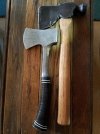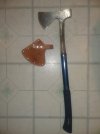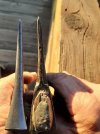I just got back from a local garage sale and I got an Estwing hatchet and a rock hound pick/hammer. I got both of the Estwing tools for a song and they are used but in overall good condition.
Not having a lot of expertise in the area of hatchets and/or axes so I thought I would get your input. I've been putting together a small collection of axes and hatchets that I've found at garage sales and thrift stores. So I don't have a big investment. But I do want to stay with quality tools to build the collection with.
I've also owned other Estwing tools over the years and I personally think they are pretty decent quality overall. Oh I'm sure that exotic brands like Grandfors Bruks and a few others I could mention are probably better. But I still think that these Estwing striking tools are as good as I would ever need for my own uses.
So I was wanting to get some feedback from you guys who are really serious about axes and hatchets and get an idea of where ESTWING ranks in quality of their axes and hatchets?
Not having a lot of expertise in the area of hatchets and/or axes so I thought I would get your input. I've been putting together a small collection of axes and hatchets that I've found at garage sales and thrift stores. So I don't have a big investment. But I do want to stay with quality tools to build the collection with.
I've also owned other Estwing tools over the years and I personally think they are pretty decent quality overall. Oh I'm sure that exotic brands like Grandfors Bruks and a few others I could mention are probably better. But I still think that these Estwing striking tools are as good as I would ever need for my own uses.
So I was wanting to get some feedback from you guys who are really serious about axes and hatchets and get an idea of where ESTWING ranks in quality of their axes and hatchets?



